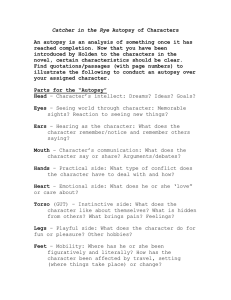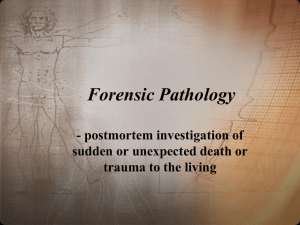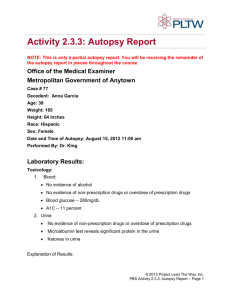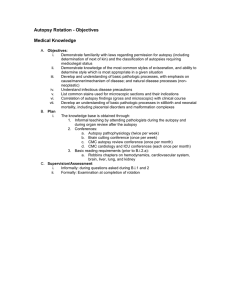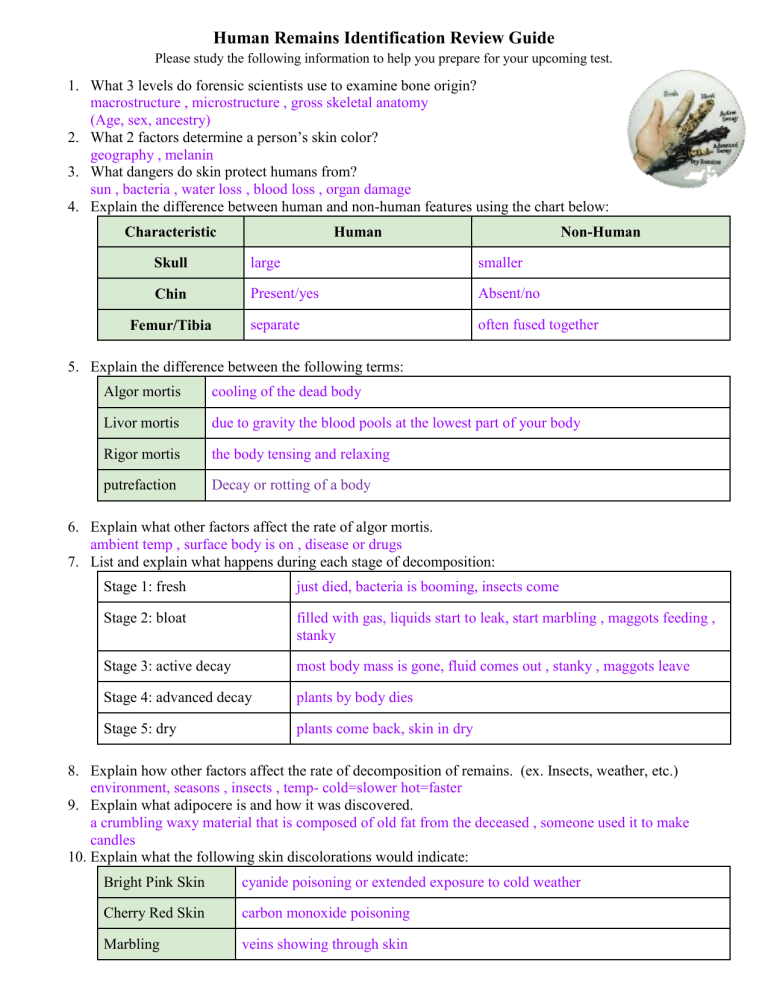
Human Remains Identification Review Guide Please study the following information to help you prepare for your upcoming test. 1. What 3 levels do forensic scientists use to examine bone origin? macrostructure , microstructure , gross skeletal anatomy (Age, sex, ancestry) 2. What 2 factors determine a person’s skin color? geography , melanin 3. What dangers do skin protect humans from? sun , bacteria , water loss , blood loss , organ damage 4. Explain the difference between human and non-human features using the chart below: Characteristic Human Non-Human Skull large smaller Chin Present/yes Absent/no separate often fused together Femur/Tibia 5. Explain the difference between the following terms: Algor mortis cooling of the dead body Livor mortis due to gravity the blood pools at the lowest part of your body Rigor mortis the body tensing and relaxing putrefaction Decay or rotting of a body 6. Explain what other factors affect the rate of algor mortis. ambient temp , surface body is on , disease or drugs 7. List and explain what happens during each stage of decomposition: Stage 1: fresh just died, bacteria is booming, insects come Stage 2: bloat filled with gas, liquids start to leak, start marbling , maggots feeding , stanky Stage 3: active decay most body mass is gone, fluid comes out , stanky , maggots leave Stage 4: advanced decay plants by body dies Stage 5: dry plants come back, skin in dry 8. Explain how other factors affect the rate of decomposition of remains. (ex. Insects, weather, etc.) environment, seasons , insects , temp- cold=slower hot=faster 9. Explain what adipocere is and how it was discovered. a crumbling waxy material that is composed of old fat from the deceased , someone used it to make candles 10. Explain what the following skin discolorations would indicate: Bright Pink Skin cyanide poisoning or extended exposure to cold weather Cherry Red Skin carbon monoxide poisoning Marbling veins showing through skin Tardieu Spots dark purple small spots on skin , caused by capillaries bursting under the skin 11. Explain how rigor mortis progresses throughout the body. (starts in the……moves to the …) head , torso , arms/legs , head , torso , arms/legs 12. List the 2 ways that a temperature would be taken on a decedent. liver or booty hole (rectum) 13. List the 5 manners of death. fresh , bloat , active decay , advanced decay , dry 14. Who can determine if an autopsy is needed but may not have forensic or medical training? coroner 15. Who can perform an autopsy? physician trained in pathology 16. What type of incision is made to start an internal autopsy? y-shaped 17. Explain what can be tested during an autopsy to test for the presence of drugs. vitreous humor 18. How long has it been since death if food is found in the small intestine during an autopsy? 4-8 hours 19. Explain what happens to each organ that is taken out of the body during an autopsy. it is weighed and sampled 20. Where are defensive wounds usually found on a body during an autopsy? legs , feet , hands , arms 21. Explain how wounds are documented on a body by investigators.. pictures and measures 22. Give an example of an object that could be used to create an incised wound. broken glass 23. Explain how bruises can be used in investigations and what type of victims may have them.. victims of violence , sexual assault , child abuse , vulnerable adult abuse 24. What information can investigators get from an abrasion on a body? the direction of force 25. Determine the approximate time of death if you found the following bodies using your knowledge of algor mortis. a. A body is found with a temperature of 13°C 37 hrs 32 mins b. A body is found with a temperature of 27.8°C 11 hrs 48 mins

